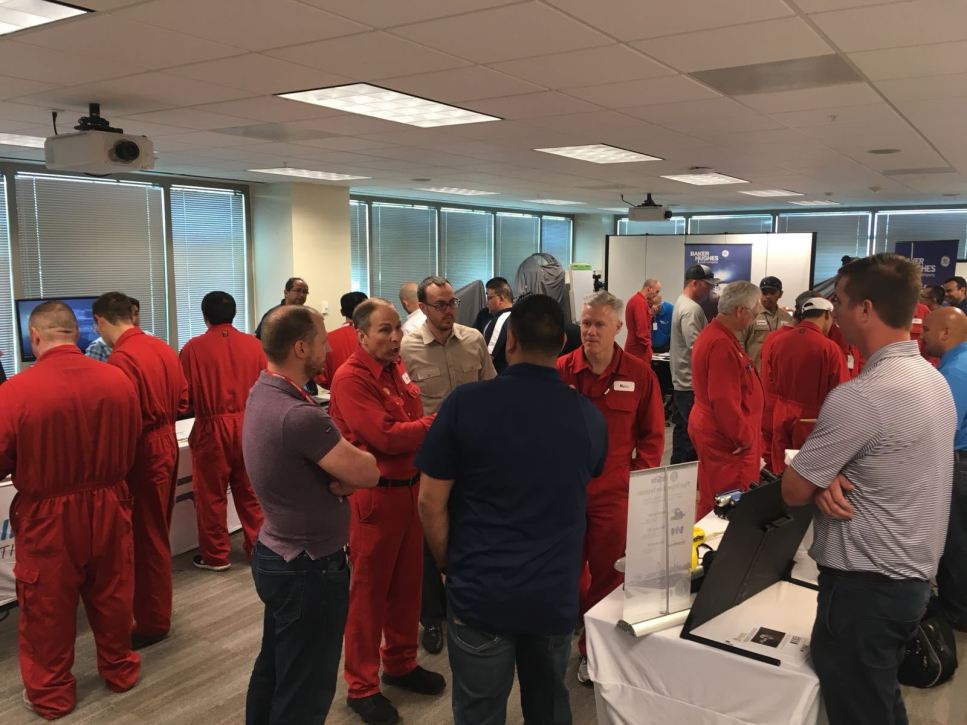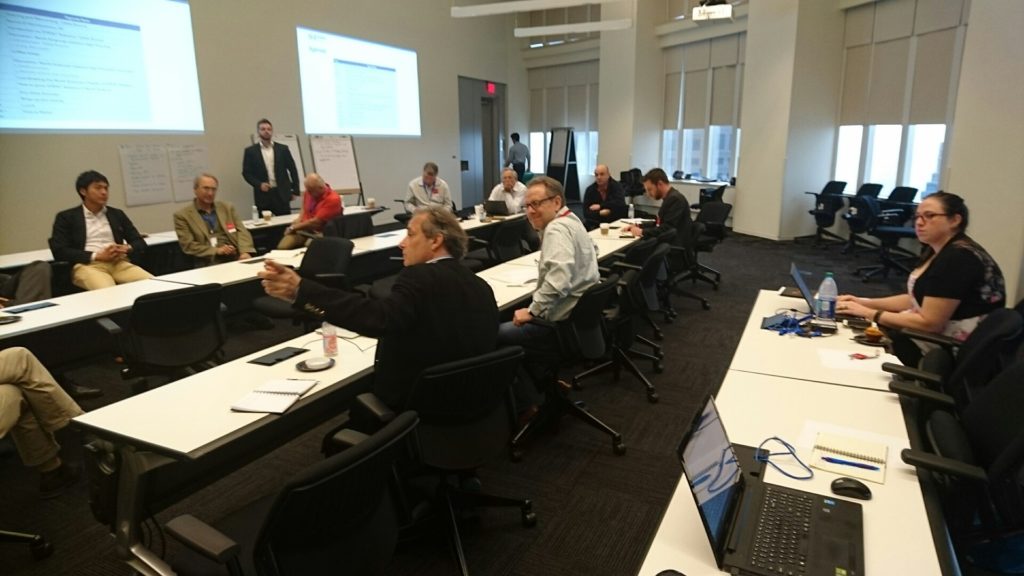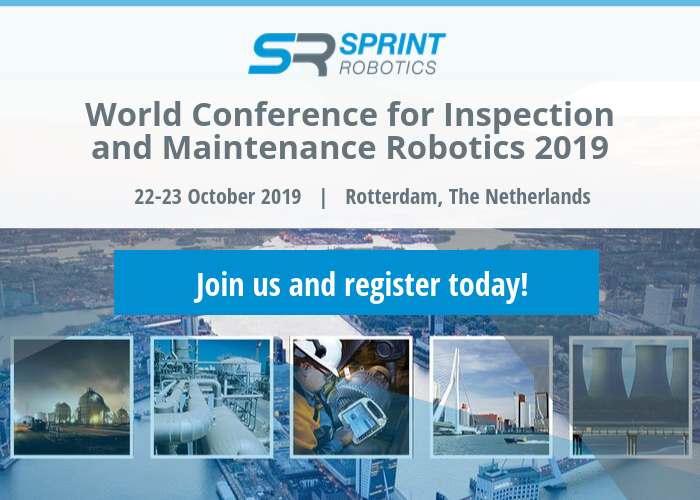BASF Freeport hosted a SPRINT Robotics demo day along with GE Inspection Robotics. Source: BASF, Sprint Robotics
Between robotics clusters such as that around Boston and organizations such as the Advanced Robotics for Manufacturing, or ARM, Institute, there are plenty of role models for encouraging developers and startups by region or industry. In the Netherlands, the SPRINT Collective is a nonprofit foundation intended to “gather a global community to share the innovative progress and rapid development of robotics techniques and solutions,” starting with infrastructure inspection for oil and gas.
The industry-driven organization will be hosting the World Conference for Inspection and Maintenance Robotics in Rotterdam, the Netherlands on Oct. 22 and 23, 2019. The event will cover market sectors ranging from petrochemical and energy to public and water infrastructure, aerospace, subsea, and next-generation technologies.
The team at the SPRINT Robotics Collective answered the following questions from The Robot Report:
How did SPRINT Robotics come about? If robots, drones, and unmanned systems have been conducting utility and infrastructure inspections for years, why is there a need for your organization now?
The SPRINT Robotics Collaborative was officially launched in January 2015 by a number of large asset owners from the oil and gas industry to encourage the worldwide use of robotics for inspection, cleaning, and maintenance. SPRINT Robotics aims to achieve field use of inspection and maintenance robotics of capital-intensive infrastructure assets on a large scale.
We intend to address immediate needs and long-term industry priorities, such as connecting the value chain, developing best practices, and fast-tracking innovations. We also want to remove barriers to entry, encourage knowledge sharing, reduce cost, increase quality, and control the risk of inspection activities.
The deployment of robots in these domains will improve human safety, minimize the impact on environment, reduce shutdown time due to the non-intrusive nature, avoid human entry of vessels and other equipment, and reduce the costs for cleaning and scaffolding.
How big is your organization now, in terms of membership?
SPRINT Robotics currently has 20 Participants — asset owners and operators — and more than 50 Associate Participants — technology developers and suppliers, service providers — from around the globe. SPRINT Robotics includes three regional chapters: Europe, North America, and Asia-Pacific. At the next World Conference, we expect more than 400 thought leaders in the industry to gather in Rotterdam.
How important is government support? Are you working with other industry groups or similar organizations to yours around the world?
SPRINT Robotics is almost entirely funded by its Associate Participants, and we don’t rely on government support. The Smart Water Networks Forum (SWAN) and the SPRINT Robotics Collaborative signed a memorandum of understanding (MoU) to promote the use of robotics for inspection and maintenance in the water sector. Both organizations expressed their intent to establish a mutually beneficial partnership that will accelerate the global smart-water sector.
This MoU is part of a drive to leverage cross-sectoral initiatives of robotic development and deployment between the oil, gas, energy, and water sectors. Partnering with the SWAN Forum provides exciting prospects to create synergies between sectors, share knowledge and best practices, as well as connect leading experts in the respective industries.
In addition, we maintain close communications with other industry organizations like NACE, ASME, API, IEEE, EEMUA, and HOIS. Each of them has points that touch on the inspection and maintenance robotics domain that we are addressing.
What outreach are you doing to robotics developers and suppliers? Can you name some robotics and end-user companies you’re working with?
“A unique aspect of SPRINT Robotics is that we start from the asset operator perspective,” said Tjibbe Bouma, chairman of SPRINT Robotics. “Robotics developers and suppliers come to SPRINT exactly for that reason; we connect real-world problems to potential robotic solutions.”
Roadshows, which bring typically groups of 10 to 15 vendors of robotics systems or services to industrial facilities, have become integral in bringing end users together with technology suppliers. In 2019, SPRINT Robotics organized roadshows in the U.S., Scotland, Australia, Canada, southern Europe, and Southeast Asia.

Roadshows are opportunities to connect inspection robotics developers, vendors, and users. Source: SPRINT Robotics
The roadshows bring robotics straight to the doorstep of end users and provide a platform for direct engagement. The roadshows help to create awareness of the existence of these tools, showcase technology in interactive manner, and spark ideas and dialogue to address specific challenges.
What are some regional differences in awareness, development, and use of robotics for inspection and maintenance?
The Gulf Coast is a petrochemical hub in the U.S., and SPRINT Robotics has held two extensive roadshows in the area. Houston has been a focal point of SPRINT Robotics since its inception, and the North American chapter of SPRINT Robotics was launched in Houston. SPRINT Robotics’ first World Conference for Inspection and Maintenance Robotics was held in Galveston, Texas.
Innovation in the area of robotics is strong academically in Australia, and we have held a roadshow in Perth. There are not a lot of international players for inspection and maintenance robots, but the country is very well positioned for sectors such as mining. Asset operators in Australia are interested in implementing robotics for their operations, as many assets are remote, and the cost of deploying people is very high. Environmental conditions are front and center for Australian operators.

Chevron, Gassco, Shell, and Statoil founded SPRINT Robotics, which held its first North American chapter meeting in Houston. Source: SPRINT Robotics
Compared with Europe, these regions are less used to the collaborative approach that we are promoting. Nevertheless, we find that collaborative initiatives are important to helping many applications gain traction in the market.
Even very large asset operators find that their organizations are highly distributed, and the market volume offered locally by one of their facilities is too small to support robotic service development by the supply chain. Only once service providers can address multiple clients in one area does the volume becomes attractive enough to warrant an investment. This requires alignment in technical and operational practices between large operators and acceptance of new robotics solutions across the industry.
Are you tracking emerging technologies, such as machine learning, swarm robotics, the Internet of Things (IoT), and 5G wireless networking?
All of these technologies will affect robotics for inspection and maintenance. With respect to IoT, we try to understand where solutions are appropriate and where robotics is needed. This helps to focus the efforts of our community on those applications that can really add value.

The Robot Report is launching the Healthcare Robotics Engineering Forum, which will be on Dec. 9-10 in Santa Clara, Calif. The conference and expo will focus on improving the design, development, and manufacture of next-generation healthcare robots. Learn more about the Healthcare Robotics Engineering Forum, and registration is now open.
What are some of the themes and highlights of your upcoming event in Rotterdam?
SPRINT Robotics continues to grow at a rapid pace, not only in numbers, but also with the expansion to other market sectors. The program at the World Conference for Inspection and Maintenance Robotics 2019 reflects this.
The two-day program includes over 60 international speakers, networking opportunities, an evening banquet in Rotterdam harbor, panel discussions, and an exhibition showcasing robotic solutions from more than 50 technology and service providers from the industrial inspection, maintenance, and cleaning domain. Exhibitors include ANYbotics, Clearpath Robotics, and HEBI Robotics.
Who are some noteworthy speakers, and what are some key topics to be discussed?
Keynote speakers at this year’s conference include SPRINT Robotics Chairman Tjibbe Bouma, Rebecca Wiles, head of upstream technology at BP, and Frits Eulderink, member of the executive board and chief operating officer of [tank storage company] Royal Vopak. More will be announced.
One highlight at this year’s conference will be the official presentation of the “Guidelines for the Application of Robotics for In-Service Inspection of Above Ground Storage Tanks”.
Deployment of robotics for in-service inspection and cleaning of storage tanks is still a challenge in the oil, gas, and petrochemical industry, not only with respect to safety, but also in the acceptance of inspection results by relevant authorities.
As part of our roadmap, SPRINT Robotics initiated and developed these guidelines to set minimum quality standards and promote uniformity in the operational procedures carried out by different organizations. The guidelines aim to facilitate an accelerated yet responsible adoption of in-service robotic inspection for storage tanks. The guidelines have been reviewed and approved by the SPRINT Robotics Action Group for Storage Tanks.



